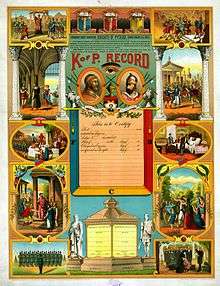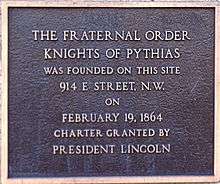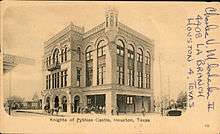Knights of Pythias


The Knights of Pythias is a fraternal organization and secret society [2] founded in Washington, D.C., on 19 February 1864.

The Knights of Pythias was the first fraternal organization to receive a charter under an act of the United States Congress.[3] It was founded by Justus H. Rathbone, who had been inspired by a play by the Irish poet John Banim about the legend of Damon and Pythias. This legend illustrates the ideals of loyalty, honor, and friendship that are the center of the order.
The order has over 2,000 lodges in the United States and around the world, with a total membership of over 50,000 in 2003. Some lodges meet in structures referred to as Pythian Castles.
Sword
Early in the group's history, when a man was inducted into the Knights of Pythias, he received a ceremonial sword.[4] Such swords might be given to a Pythian by family members, business associates, or others as a token of esteem. In recent decades, rather than require each member to own a sword, the local chapter maintains a collection of swords for use by its members. Long, narrow swords are generally used in public during parades and drills, while short swords are used in displays.
Markings on swords varied widely. Most swords were inscribed with the acronym "FCB", which stands for the Pythian motto ("Friendship, Charity, Benevolence"). Images on swords were also somewhat common, and included: A man, woman and child (symbolic of Pythias saying good-bye to his family); a man looking out of a building, with a group of people below (symbolic of Damon's pending execution); a man between some pillars, pulling them down (similar to Samson destroying his enemy's temple); or various types of weapons (swords, axes, hammers, etc.). A full Knight of the Pythian order often inscribed his sword with the image of a knight's helmet with a lion on the crest. Many also carried the image of a sprig of myrtle (the Pythian symbol of love) or a falcon (the Pythian symbol of vigilance).
Organization
The structure of the Knights of Pythias is three-tiered. The local units used to be called "Castles," but over time came to be called "Subordinate Lodges." State and provincial organizations are called "Grand Lodges" and the national structure is called the "Supreme Lodge" and meets in convention biennially. The officers of the Supreme Lodge include the sitting Past Supreme Chancellor, Chancellor, Vice-Chancellor, Prelate, Secretary, Treasurer, Master at Arms, Inner Guard and Outer Guard.[5]
The order's auxiliaries are the Pythian Sisters, and two youth organizations: the Pythian Sunshine Girls and the Junior Order of Princes of Syracuse for boys.[6]
The Knights of Pythias also has a side degree, the Dramatic Order of the Knights of Khorassan,[7] which itself has a female auxiliary, the Nomads of Avrudaka.[8] Finally, members who have obtained the Knight Degree may join the Uniformed Rank, which participated in parades and other processions.[7] Swords owned by a member of the Uniformed Rank might be inscribed with the acronym "UR," a dove, or a lily. (The Uniformed Rank was banned in the organization in the 1950s.)
Membership
Membership has historically been open to males in good health who believe in a Supreme Being. Maimed individuals were not admitted until 1875. Members are accepted by blackball ballot.[7]
By the end of the so-called "Golden Age of Fraternalism" in the early 1920s, the order had nearly a million members. By 1979, however, this number had declined to fewer than 200,000.[9]
Ritual
The degrees of Pythian Knighthood in a subordinate lodge (or "Castle") are:
- Page
- Esquire
- Knight
In 1877, the order adopted an optional fourth degree, called the Endowment Rank, which provided fraternal insurance benefits. In 1930, this department split from the Knights of Pythias and became a mutual life insurance company, later known as the American United Insurance Company.[9]
A member must be at least 18 years of age, not be a professional gambler or involved with illegal drugs or alcohol, and he must have a belief in a Supreme Being. The oath taken by members:
I declare upon honor that I believe in a Supreme Being, that I am not a professional gambler, or unlawfully engaged in the wholesale or retail sale of intoxicating liquors or narcotics, and that I believe in the maintenance of the order and the upholding of constituted authority in the government in which I live. Moreover, I declare upon honor that I am not a Communist or Fascist; that I do not advocate nor am I a member of any organization that advocates the overthrow of the Government of the Country of which I am a Citizen, by force or violence or other unlawful means; and that I do not seek by force or violence to deny to other persons their rights under the laws of such country.[10]
Philanthropy
The order provides for "worthy Pythians in distress" and has given aid to victims of national or sectional disasters. It runs camps for underprivileged youth and homes for aged members. It has sponsored scholarship funds, blood drives, highway safety programs, and the Cystic Fibrosis Research Foundation.[9]
Other Pythian organizations
Knights of Pythias of North and South America, Europe, Asia, and Africa
After a black lodge was denied a charter by the Knights of Pythias' Supreme Lodge meeting in Richmond, Virginia on March 8, 1869, a number of black Americans who had been initiated into the order formed their own Pythian group, the Knights of Pythias of North and South America, Europe, Asia, and Africa. By 1897, the KPNSAEAA had 40,000 members, with Grand Lodges in 20 states and other lodges in the West Indies and Central America. It distributed $60,000 worth of benefits annually and had a woman's auxiliary and uniformed rank.[11]
Canada
The Grand Lodge of Ontario was instituted on April 8, 1872. Rowena L. Rooks composed "K of P grand march [for piano]," which was dedicated to Collin H. Rose, Grand Chancellor, and the officers and representatives of the Grand Lodge K of P of Ontario, Canada. The march sheet music, which was published in London, Ontario, by C. F. Colwell, circa 1876, was illustrated with the Knights of Pythias emblem and Latin motto, Amico Fidus ad Aras, or in English, "True friends are a refuge.".[12]
Improved Order, Knights of Pythias
In 1892, the Supreme Lodge ruled that the work of the order would only be conducted in English. This upset some members who were accustomed to using German. After this ruling was reiterated at the Supreme Lodges of 1894 and 1895, a number of German-speaking Pythians split off and formed the Improved Order, Knights of Pythias at a convention in Indianapolis in June 1895. The new order was reportedly not very popular, and a movement toward reconciliation occurred a few years later.[13]
Notable Pythian Knights
- Louis Armstrong, jazz trumpeter and singer
- Hugo Black, U.S. Supreme Court Justice[14]
- Clifford Cleveland Brooks, member of the Louisiana State Senate from 1924 to 1932 from northeast delta parishes[15]
- William Jennings Bryan, U.S. Secretary of State and presidential candidate[16]
- Benjamin Cardozo, U.S. Supreme Court Justice[17]
- J. J. Carter, state representative, mayor, school board member, and parish police juror from Webster Parish, Louisiana[18]
- Leopold Caspari, member of both houses of the Louisiana State Legislature[19]
- Robert Houston Curry, member of the Louisiana House of Representatives from 1888 to 1892 for Bossier Parish[20]
- Brevet Major Augustus P. Davis, founder of the Sons of Union Veterans of the Civil War [21]
- U. T. Downs, sheriff of Rapides Parish, Louisiana, 1924–1940[22]
- Eliot Engel, Congressman, New York [23]
- John W. Grabiel, Republican gubernatorial nominee in Arkansas in 1922 and 1924[24]
- Leroy Milton Grider (1854–1919), California real-estate developer
- Warren G. Harding, U.S. President[25]
- Hubert Horatio Humphrey, U.S. Vice President[26]
- Bob Jones, Sr., founder of Bob Jones University, prominent evangelist[27]
- Claud H. Larsen, member of the Wisconsin State Assembly
- W. Matt Lowe, mayor of Minden, Louisiana 1916-1920, parish police juror[28]
- John Ellis Martineau, Governor of Arkansas, U.S. District Judge for the Eastern District of Arkansas[29]
- Frank McDonough, member of both houses of the Wisconsin Legislature[30]
- William McKinley, U.S. President[31]
- Alexander P. Riddle lieutenant governor of Kansas
- Nelson A. Rockefeller, U.S. Vice President[31]
- Franklin D. Roosevelt, U.S. President, who joined in 1936, during his presidency[9]
- William Green Stewart, Louisiana farmer and school board president[32]
- Lee Emmett Thomas, mayor of Shreveport, and Speaker of the Louisiana House of Representatives[33]
- Lew Wallace, author, territorial governor of New Mexico, major general (U.S. Army), diplomat[34]
Notable Pythian buildings


- (by state then city)
- Knights of Pythias Building (Phoenix, Arizona), NRHP-listed[35]
- Pythian Castle (Arcata, California), in Humboldt County, California, NRHP-listed[35]
- Pythias Lodge Building (San Diego, California), NRHP-listed[35]
- Knights of Pythias Lodge (Salida, Colorado)[36]
- Knights of Pythias Lodge Hall (Weiser, Idaho), NRHP-listed[35]
- Knights of Pythias Building and Theatre, Greensburg, Indiana, NRHP-listed[35]
- Knights of Pythias Lodge (South Bend, Indiana), NRHP-listed[35]
- Knights of Pythias Temple (Louisville, Kentucky), NRHP-listed[35]
- Pythian Temple, New Orleans, Louisiana
- Pythian Opera House, Boothbay Harbor, Maine
- Eagle Harbor Schoolhouse, Eagle Harbor, Michigan, NRHP-listed[35] - where Justus Rathbone developed the idea of the order
- Pythian Home of Missouri, also known as Pythian Castle
- Knights of Pythias Building (Virginia City, Nevada)
- Pythian Temple (New York City)
- Pythian Temple and James Pythian Theater, Columbus, Ohio
- Pythian Castle (Toledo, Ohio), NRHP-listed in Lucas County
- Knights of Pythias Pavilion, Franklin, Tennessee, NRHP-listed[35]
- Knights of Pythias Temple (Dallas, Texas), also known as the Union Bankers Building
- Knights of Pythias Building (Fort Worth, Texas), also known as Pythian Castle Hall
- Pythian Castle (Portsmouth, Virginia), NRHP-listed[35]
- Pythian Temple (Tacoma, Washington), NRHP-listed[35]
- Pythian Castle Lodge, Milwaukee, Wisconsin, NRHP-listed[35]
In Fiction
The Knights are mentioned in Sunshine Sketches of a Little Town by Stephen Leacock; an ill-fated marine excursion organised by the Knights is the subject of Chapter 3, entitled "The Marine Excursion of the Knights of Pythias". Several characters in the book are said to be members of the Knights. [37]
See other
Notes and references
- ↑ Caption: "Friendship, Charity, Benevolence. Knights of Pythias. Founded February 19th, 1864. The Order is founded upon naught but the purest and sincerest motives. Its aim is to alleviate the suffering of a brother, succor the unfortunate, zealously watch at the bedside of the sick, soothe the pillow of the dying, perform the last sad rights [sic] at the grave of a brother; offering consolation to the afflicted, and caring, with all a brother's love, for the widow and orphan. Brotherly love and charity are the Pillars on which it rests; Friendship and Truth the bond and surety of its preservation. Peace on earth and goodwill toward men. K. of P. Record. Certificate of Membership. This is to Certify That — was initiated as Page in — Lodge N° — Located at — State of — on the — day of 18 — Charged as Esquire — day of 18 — and proved as Knight — day of 18 — . In memory of brother — born — died — aged — yrs. — ms. — dys. In memory of sister — born — died — aged — yrs. — ms. — dys. Entered according to Act of Congress in the y. 1889 by J. M. Vickeroy, in the Office of the Librarian of Congress at Washington, D. C. Published by J. M. Vick[e]roy & Co., Terre-Haute, Indiana."
- ↑ Carnahan, James R. Pythian Knighthood: Its History and Literature, 2nd Ed, Revised and Enlarged. The Pettibone Manufacturing Company, Fraternity Publishers, Cincinnati, 1892.
- ↑ Approved May 5, 1870 [16 Stat. at L. 98, chap. 80]
- ↑ Glickman, Lawrence B. Consumer Society in American History: A Reader. Ithaca, N.Y.: Cornell University Press, 1999, p. 223.
- ↑ Schmidt, Alvin J. Fraternal Organizations Westport, CT; Greenwood Press p. 186
- ↑ Schmidt pp.184-5
- 1 2 3 Schmidt p. 184
- ↑ "Nomads of Avrudaka". Fezmuseum.com. Archived from the original on 2013-10-28. Retrieved 2013-11-16.
- 1 2 3 4 Schmidt p. 185
- ↑ Application for Membership.
- ↑ Stevens, Albert C. Cyclopedia of Fraternities: A Compilation of Existing Authentic Information and the Results of Original Investigation as to the Origin, Derivation, Founders, Development, Aims, Emblems, Character, and Personnel of More Than Six Hundred Secret Societies in the United States. E. B. Treat and Company, New York p.266
- ↑ AMICUS No. 5379212 Library and Archives Canada, Sheet music from our past.
- ↑ Stevens p. 238
- ↑ "Hugo L. Black". Encyclopedia of Alabama. Retrieved 12 May 2017.
- ↑ Henry E. Chambers, History of Louisiana, Vol. 2 (Chicago and New York City: The American Historical Society, Inc., 1925, p. 71)
- ↑ Lawrence Kestenbaum. "Knights of Pythias, politicians, Nebraska". The Political Graveyard. Retrieved 2013-11-16.
- ↑ Benjamin N. Cardozo Lodge at www.cardozospeaks.org
- ↑ C. W. Barnum. "Webster Parish, Louisiana, History and Genealogy". laahgp.genealogyvillage.com. Retrieved March 11, 2015.
- ↑ "Caspari, Leopold". Louisiana Historical Association, A Dictionary of Louisiana Biography (lahistory.org). Retrieved December 22, 2010.
- ↑ "Curry, Robert H.". The Political Graveyard. Retrieved July 24, 2015.
- ↑ "Biography of A. P. Davis, Founder of SUVCW". suvcw.org. Retrieved 12 May 2017.
- ↑ Henry E. Chambers, A History of Louisiana: Wilderness, Colony, Province, Territory, State, People, (Chicago and New York City: American Historical Society, Inc., 1925), pp. 245-246
- ↑ "Eliot Engel". NNDB. Retrieved 12 May 2017.
- ↑ "John W. Grabiel". ebooksread.com. Retrieved August 23, 2012.
- ↑ Lawrence Kestenbaum. "Knights of Pythias, politicians, California". The Political Graveyard. Retrieved 2013-11-16.
- ↑ Lawrence Kestenbaum. "Knights of Pythias, politicians, Minnesota". The Political Graveyard. Retrieved 2013-11-16.
- ↑ History of Alabama and dictionary of Alabama biography, Volume 3, 940.
- ↑ "Ex-Mayor of Minden Dies at 83", The Shreveport Times, March 5, 1955, p. 8-B
- ↑ Lawrence Kestenbaum. "Freemasons, politicians, Arkansas". The Political Graveyard. Retrieved 2013-11-16.
- ↑ "Bio: McDonough, Frank (1846 - 1904)". Clark County History Buffs. Retrieved 2016-05-29.
- 1 2 Lawrence Kestenbaum. "Knights of Pythias, politicians, New York". The Political Graveyard. Retrieved 2013-11-16.
- ↑ ""William Green Stewart" in Biographical and Historical Memoirs of Northwest Louisiana". Chicago and Nashville, Tennessee: The Southern Publishing Company. 1890. Retrieved March 14, 2015.
- ↑ "Thomas, Lee Emmett". Louisiana Historical Association, A Directory of Louisiana Biography (lahistory.org). Retrieved December 29, 2010.
- ↑ Crawfordsville Saturday Evening Journal, June 19, 1875
- 1 2 3 4 5 6 7 8 9 10 11 12 "National Register Information System". National Register of Historic Places. National Park Service. 2009-03-13.
- ↑ "Knights of Pythias - Salida, Colorado". WayMarking. Retrieved 30 July 2017.
- ↑ Various (2007). Nischik, Reingard M., ed. The Canadian Short Story: Interpretations. Camden House. ISBN 9781571131270.
External links
| Wikimedia Commons has media related to Knights of Pythias. |